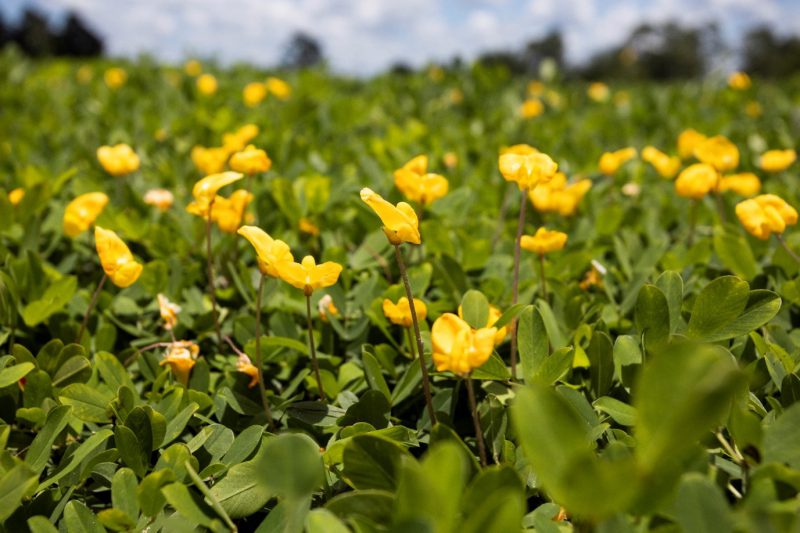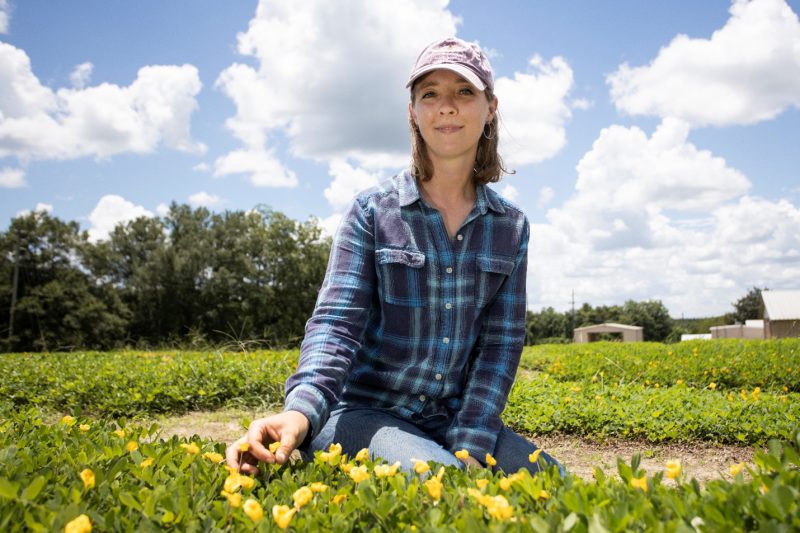
Perennial peanut is a beautiful option for ornamental option landscaping or as a turf alternative with low nitrogen requirements. Credit: Tyler Jones, UF/IFAS
Kelly Thomas, Ann Blount, Gary Knox, and Cheryl Mackowiak, UF/IFAS North Florida Research and Education Center, Quincy
This is the time of year when we begin to see perennial peanut peeking out from under the soil and showing small leaves that signal the starting of spring. Many of us in the Florida Panhandle, Peninsular Florida and other southern coastal states are getting familiar with this perennial legume. Often, we know it for its valuable, high protein hay, as it is often referred to as the “Alfalfa of the South”. More recently, we have been exploring its use in pasture systems, where it provides a perennial legume component to a perennial grass system. Now we are also looking at perennial peanut from an ornamental perspective for use in landscaping and as a turfgrass alternative .

Ornamental perennial peanut field plots at the North Florida Research and Education Center-Quincy. Credit: Ann Blount, UF/IFAS
–
What is perennial peanut?
Most perennial peanuts are Arachis glabrata Benth., also known as “rhizoma” perennial peanut, because of its extensive rhizome rooting structure. The plant is a yellow-flowering legume that is native to South America, from rangelands of Paraguay, Brazil, Uruguay and Argentina.
Selection for release of cultivars at the University of Florida has been based primarily on its use as a high-quality hay crop, and forage producer. Lower-growing selections of rhizoma perennial peanut have been released for ornamental use by University of Florida and USDA-NRCS: ‘Ecoturf’, ‘Arblick’, ‘Pointed Leaf’ and ‘Waxy Leaf’, and the University of Georgia’s ‘Cowboy’. The popularity of these as ornamental options has recently increased because of environmental concerns and costs associated with nitrogen fertilization. This plant is now being suggested as a turfgrass replacement and ornamental groundcover for residential and urban landscapes. Ornamental rhizoma peanut (ORP) requires minimal irrigation, less frequent mowing, and fewer fertilizer applications compared to St. Augustine grass and other popular southern turfgrass species.

Kelly Thomas, Graduate Student, in her field plots of ornamental perennial peanut at the North Florida Research and Education Center-Quincy. Credit: Tyler Jones, UF/IFAS
–
Despite ornamental perennial peanut’s acceptance by the green industry, not much is known about consumers’ preferences regarding the potential adoption of this plant.
Based on this lack of knowledge, we developed a survey using an online survey software (Qualtrics, Provo, UT) and distributed this via email to newsletter subscribers, gardening groups, and green industry contacts in 2021. The objective of the survey was to collect information on Florida consumers’ preferences and challenges associated with buying or growing ornamental types. A total of 908 survey responses were submitted and 853 respondents completed the survey (93.9% completion rate). Most survey respondents identified themselves as residential home owners (89%), over the age of 65 (59.7%). Out of the survey population, 35% of 874 respondents had purchased ornamental perennial peanut in the past, and 91% of 863 respondents would purchase or consider purchasing it in the future. Most plants purchased by survey participants were growing in a pot/container; most did not know the cultivar/variety name of the plant purchased. Regardless of use, survey respondents prefer that ornamental perennial peanut flowers frequently and heavily in the residential or urban landscape. Most survey respondents favored mowing infrequently (“once or twice a year” or “never”). When asked to rank the most important benefits provided by groundcovers/turfgrass alternatives, consumers valued reducing herbicides/pesticide and fertilizer/water usage and preventing weed establishment. Based on the survey results, ornamental selections that flower regularly and heavily and remain short in stature would be preferable to consumers. In Florida, there is a demand for ornamental types of perennial peanut. However, survey respondents identified the top challenge associated with growing or buying the plant as a lack of availability. Proper labeling of ORP products and consumer knowledge of ORP cultural care, uses, and increasing the cultivars/varieties available are our future focus for promoting this novel green product.
The Perennial Peanut Producers Association will host their annual field day at the North Florida Research and Education Center at Quincy on June 2, 2022. The field day will feature speakers and poster sessions, as well as a tour of field plots. Many ornamental and forage perennial peanut varieties and advanced lines will be showcased. For more information please contact your local extension office and check the calendar of events for the Panhandle Ag e-News.
For more information on this research project, watch the video:
- Cool-Season Forages – A Pasture Perspective for 2022 - September 16, 2022
- Ornamental Rhizoma Perennial Peanut for Groundcover or Alternative Turf - March 18, 2022
- 2021 Cool-Season Forage Recommendations for Livestock and Wildlife - September 24, 2021
